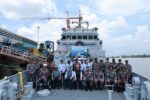In a rare public disclosure, China’s People’s Liberation Army (PLA) has revealed that it recently conducted a simulation involving successive nuclear strikes. The exercise was designed to test the survivability of its strategic forces and the operational continuity of command and control (C2) systems under conditions mimicking multiple nuclear detonations. This development underscores Beijing’s growing focus on enhancing its second-strike capability amid intensifying global strategic competition.
PLA Rocket Force Tests Post-Strike Resilience
The PLA Rocket Force (PLARF), China’s primary operator of land-based nuclear missiles, released footage and details of the drill through state broadcaster CCTV on March 31, 2024. According to the report, the exercise simulated multiple incoming nuclear strikes targeting key military infrastructure. The scenario involved both high-altitude electromagnetic pulse (HEMP) effects and ground-level blast impacts.
Key elements tested included:
- Rapid transition from peacetime posture to wartime readiness
- Survivability of underground launch facilities
- Redundant communications for C2 continuity after EMP exposure
- Mobility of transporter erector launchers (TELs) post-strike
The simulation reportedly involved real-time coordination between missile brigades across multiple provinces. While no live warheads were used, the PLARF emphasized that the scenario was designed to mirror “actual combat conditions” in a strategic-level conflict involving nuclear weapons.
Strategic Significance Amid Evolving Nuclear Doctrine
This exercise marks a notable shift in China’s traditionally opaque approach to its nuclear posture. Historically committed to a “no first use” (NFU) policy since its first atomic test in 1964, Beijing has maintained a relatively modest arsenal focused on assured retaliation. However, recent developments—including silo construction in Xinjiang and Gansu provinces and deployment of advanced intercontinental ballistic missiles (ICBMs) like the DF-41—indicate an effort to bolster second-strike survivability.
The latest drill aligns with this trajectory by focusing not just on launch capabilities but also on post-strike command resilience—critical for maintaining credible deterrence under modern warfighting conditions where space-based assets and cyber-electronic warfare could severely degrade situational awareness.
Command and Control Under Nuclear Duress
A central feature of the exercise was testing hardened C2 networks under simulated electromagnetic disruption. HEMP effects from high-altitude detonations can disable unshielded electronics over wide areas—potentially neutralizing early warning systems or severing links between national leadership and field units.
The PLARF reportedly employed redundant fiber-optic links, satellite uplinks with anti-jamming protocols, and mobile command posts hardened against EMP effects. These measures reflect lessons drawn from U.S., Russian, and NATO practices where survivable C3I (command, control, communications & intelligence) is considered essential for credible deterrence.
Notably, Chinese analysts have previously expressed concern over vulnerabilities in their strategic communication architecture—particularly in scenarios involving preemptive decapitation strikes or cyber-electronic attacks aimed at paralyzing decision-making nodes.
Nuclear Mobility: TELs as Survivable Launch Platforms
The exercise also emphasized mobility as a pillar of survivability. Footage showed TELs carrying road-mobile ICBMs maneuvering through mountainous terrain before conducting simulated launches from concealed positions. This tactic complicates adversary targeting by increasing uncertainty about launcher locations post-first strike.
The DF-31AG and DF-41 are believed to be among China’s most advanced road-mobile ICBMs capable of carrying multiple independently targetable reentry vehicles (MIRVs). Their deployment enhances Beijing’s ability to maintain retaliatory capability even if fixed silos are compromised.
Implications for Regional Stability and Arms Control
This publicized demonstration comes amid heightened tensions with both the United States and regional actors such as India over contested borders and maritime claims. It also coincides with increased U.S. attention on Chinese strategic modernization—as reflected in Pentagon reports warning about China potentially tripling its warhead stockpile by 2035.
While Beijing insists that its NFU policy remains unchanged, exercises like this may signal a shift toward greater operational readiness for limited nuclear use scenarios—or at minimum an effort to signal resolve through enhanced transparency about capabilities without altering declared doctrine.
The lack of arms control dialogue between China and other major powers adds further uncertainty. Unlike Russia or the U.S., China is not party to any bilateral or multilateral arms limitation treaties covering delivery systems or warhead numbers—raising concerns about unchecked escalation risks during crises involving misperception or miscalculation.
A Growing Focus on Strategic Deterrence Modernization
This simulation is part of broader efforts by China’s Central Military Commission (CMC) to modernize all legs of its strategic triad—including advances in submarine-launched ballistic missiles (SLBMs), hypersonic glide vehicles like the DF-ZF, space-based early warning satellites such as Yaogan series constellations, and AI-enhanced decision support tools for rapid threat assessment.
Taken together with recent satellite imagery showing progress at missile silo fields near Hami and Yumen—and reports of new Type 096 SSBN development—the PLARF’s successive strike simulation reflects an increasingly sophisticated approach toward ensuring credible deterrence across multiple domains under complex threat environments.









